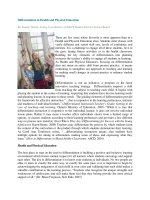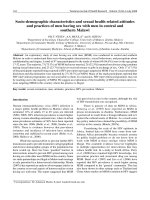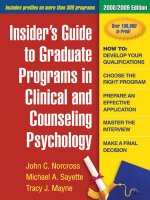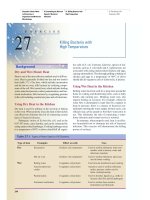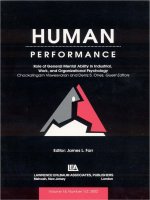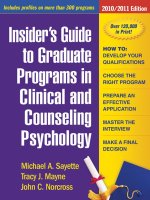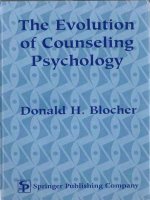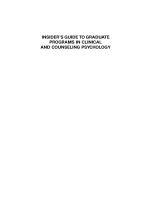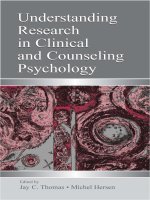UNDERSTANDING RESEARCH IN CLINICAL AND COUNSELING PSYCHOLOGY doc
Bạn đang xem bản rút gọn của tài liệu. Xem và tải ngay bản đầy đủ của tài liệu tại đây (1.69 MB, 491 trang )
UNDERSTANDING RESEARCH
IN CLINICAL AND COUNSELING
PSYCHOLOGY
UNDERSTANDING RESEARCH
IN CLINICAL AND COUNSELING
PSYCHOLOGY
Edited by
Jay C. Thomas
Michel Hersen
Pacific University
LAWRENCE ERLBAUM ASSOCIATES, PUBLISHERS
2003 Mahwah, New Jersey London
Senior Acquisitions Editor: Susan Milmoe
Editorial Assistant: Kristen Depken
Cover Design: Kathryn Houghtaling Lacey
Production Editor: Marianna Vertullo
Full-Service Compositor: TechBooks
Text and Cover Printer: Sheridan Books
This book was typeset in 10/12 pt. Times, Italic, and Bold.
The heads were typeset in Helvetica Bold, and Helvetica Bold Italic.
Copyright
c
2003 by Lawrence Erlbaum Associates, Inc
All right reserved. No part of this book may be reproduced in
any form, by photostat, microfilm, retrieval system, or any
other means, without prior written permission of the publisher.
Lawrence Erlbaum Associates, Inc., Publishers
10 Industrial Avenue
Mahwah, New Jersey 07430
Library of Congress Cataloging-in-Publication Data
Understanding research in clinical and counseling psychology / edited by Jay C. Thomas
and Michel Hersen.
p. cm.
Includes bibliographical references and indexes.
ISBN 0-8058-3671-3 (pbk. : alk. paper)
1. Clinical psychology—Research. 2. Counseling—Research. 3. Psychotherapy—
Research. I. Thomas, Jay C., 1951– II. Hersen, Michel.
RC467 .U53 2002
616.89
.0072—dc21 2002026377
Books published by Lawrence Erlbaum Associates are printed on
acid-free paper, and their bindings are chosen for strength and
durability.
Printed in the United States of America
10987654321
Contents
Preface vii
I RESEARCH FOUNDATIONS
1 Introduction: Science in the Service of Practice 3
Jay C. Thomas and Johan Rosqvist
2 Understanding Measurement 27
Warren W. Tryon and David Bernstein
3 Sampling Issues 69
Karl A. Minke and Stephen N. Haynes
4 Validity: Making Inferences from Research Outcomes 97
Joseph R. Scotti, Tracy L. Morris, and Stanley H. Cohen
II RESEARCH STRATEGIES
5 Group Designs 133
Jill T. Ehrenreich and Alan M. Gross
6 Correlational Methods 161
Gerald Goldstein
7 Single Subject Designs 181
Kurt A. Freeman
v
vi CONTENTS
8 Program Evaluation 209
Mark M. Greene
9 Meta-Analysis 243
Joseph A. Durlak, Inna Meerson,
and Cynthia J. Ewell Foster
III RESEARCH PRACTICE
10 Ethical Guidelines in Research 271
Catherine Miller
11 Reviewing the Literature and Evaluating Existing Data 295
Matt J. Gray and Ron Acierno
12 Planning Data Collection and Performing Analyses 319
Jay C. Thomas and Lisa Selthon
IV SPECIAL PROBLEMS
13 Effectiveness Versus Efficacy Studies 343
Paula Truax and Jay C. Thomas
14 Research in Private Practice 379
Ricks Warren and Jay C. Thomas
15 Research with Children 397
Mark D. Rapport, Robert Randall, Gail N. Shore, and
Kyong-Mee Chung
16 Research with Older Adults 441
Ruth O’Hara, Anne B. Higgins, James A. D’Andrea,
Quinn Kennedy, and Dolores Gallagher-Thompson
Author Index 469
Subject Index 479
Preface
The development of Understanding Research in Clinical and Counseling Psy-
chology is the result of our experiences teaching and working with students in
professional psychology over many years. Although virtually all graduate pro-
grams require a course on research, the basis for that requirement is often shrouded
in mystery for many students. Students enter their graduate training with the ad-
mirable ambition of learning skills important for assisting clients to make changes.
Although they understand that practice may be somehow loosely based on research
findings, the connection is not clear and the value of psychological research not
readily apparent. In this book, we introduce students to research as an indispensable
tool for practice.
This is a collaborative text. We invited authors we know to be experts in both
psychological research and practice to contribute chapters in their particular areas
of expertise. This approach has the advantage of each subject being presented by
authors who are experienced in applying the concepts and who are enthusiastic
about how the information can help both practitioners and researchers to advance
knowledge and practice in psychology. The information may at times be complex,
but it is never only of interest in the “ivory tower.” The book reflects the concerns
of the real world.
The book is divided into four parts. Part I (Foundations) contains four chap-
ters that form the basis for understanding the material in the rest of the book.
Part II (Research Strategies) consists of five chapters covering the most important
research strategies in clinical and counseling psychology. Each of these chapters
includes an illustration and analysis of a study, explaining the important decision
points encountered by the researcher and how the results can be used to inform
practice. Part III (Practice), a short section, comprises three chapters on issues re-
lated to actually planning, conducting, and interpreting research. Finally, Part IV
(Special Problems) includes four chapters. The first of these addresses one of
the most important controversies in mental health research today: the distinction
vii
viii PREFACE
between “gold standard” efficacy studies and more realistic effectiveness stud-
ies. This nicely sets the stage for the next, which discusses how a psychologist
can operate an empirically oriented practice and actually conduct research. The
remaining two chapters focus on how to perform research with children and the
elderly, respectively.
Overall, the book gives students what they need and want to know while staying
at a size appropriate for a semester long course. Many individuals have contributed
to bringing this book to fruition. First and foremost are the authors who agreed
to share their expertise and experiences with us. Second are Carole Londer´ee,
Kay Waldron, Alex Duncan, and Angelina Marchand, who provided technical
expertise. Finally, but hardly least of all, are our many friends at Lawrence Erlbaum
Associates, who understood the inherent value of this project.
Jay Thomas
Portland, Oregon
Michel Hersen
Forest Grove, Oregon
I
Research Foundations
Introduction: Science in the
Service of Practice
Jay C. Thomas
Johan Rosqvist
Pacific University, Portland, Oregon
Today, psychologists are called on to help solve an ever wider range of per-
sonal and social problems. It has been recognized that a large proportion of the
population can benefit from psychotherapeutic services. Current estimates of
the prevalence of mental disorders indicate that they are common and serious.
Sexton, Whiston, Bleuer, and Walz (1997) cited evidence that up to one in five
American adults suffers from a diagnosable mental disorder. The provision of
psychotherapy services is a multibillion dollar industry (Sexton et al., 1997). In
addition, clinicalandcounselingpsychologistsareaskedtointerveneinpreven-
tion efforts in situations involving individuals and/or families, prisons, schools,
and, along with industrial and organizational psychologists, in the work setting.
When so many people trust the advice and assistance of psychologists and
counselors, it is important that professionals rely upon a foundation of knowl-
edge that is known to be valuable. Many students in clinical and counseling
psychology wonder about the relevance of a research courses and of research
in general pertaining to their chosen profession. These students often primarily
value the role of the psychologist as helper and expect to spend their careers
helping clients in dealing with important issues. Their ambition is very worthy,
but we argue that effective helping can occur only when the best techniques
are used, and that it is only through scientific research so that we can determine
what is “best.”
We illustrate this fundamental point through a brief history of treatment for
obsessive-compulsive disorder (OCD) in which a client, “Sue,” received the
assistance she needed from an empirically based treatment.
3
4 THOMAS AND ROSQVIST
THE CASE OF SUE
Sue, a 28-year-old married woman, engaged in a broad range of avoidant and
compulsive behaviors (Rosqvist, Thomas, Egan, Willis & Haney, in press).
For example, she executed extensive checking rituals—hundreds of times per
day—that were aimed at relieving obsessive fears that she, by her thoughts or
actions, would be responsible for the death of other people (e.g., her 1-year-
old child, her husband, other people that she cared for, and sometimes even
strangers). She was intensely afraid of dying herself. She also avoided many
social situations because of her thoughts, images and impulses.
As a result of these OCD symptoms and resultant avoidant behavior, Sue
was left practically unable to properly care for herself and her child. In addition,
she was grossly impaired in her ability to perform daily household chores, such
as grocery shopping, cleaning, and cooking. Her husband performed many of
these activities for her, as she felt unable to touch many of the requisite objects,
like pots and pans, food products, cleaning equipment, and so on.
Additionally, Sue was unable to derive enjoyment from listening to music or
watching television because she associated certain words, people, and noises,
with death, dying, and particular fears. She also attributed losing several jobs
to these obsessions, compulsions, and avoidance. Sue reported feeling very
depressed due to the constricted nature of her life that was consumed with
guarding against excessive and irrational fears of death.
Sue eventually became a prisoner of her own thoughts, and was unable do
anything without horrendous fears and guilt. For all intents and purposes, she
was severely disabled by her OCD symptoms, and her obsessions, compul-
sions, and avoidance directly impacted her child and husband.
Her fears were so strong, in fact, that she eventually became uncertain that
her obsessions and compulsions were irrational, or excessive and unreasonable.
She strongly doubted the assertion that her fears would not come true, even
though she had little, if any, rational proof of her beliefs. She was unsuccessful
in dismissing almost none of her obsessive images, impulses, thoughts, or
beliefs. She had very little relief from the varied intrusions, and she reported
spending almost every waking hour on some sort of obsessive compulsive
behavior. She felt disabled by her fears and doubts, and felt that she had very
little control over them.
Obviously, Sue was living a very low quality of life. Over the course of some
years, she was treated by several mental health practitioners and participated in
many interventions, including: medication of various kinds, psychodynamic,
interpersonal, supportive, humanistic, and cognitive-behavioral therapies (in-
dividually and in groups), as both an inpatient and outpatient. Sue made little
progress and was considered for high-risk, neurological surgery. As a last-ditch
effort, a special home-based therapy emphasizing exposure and response pre-
vention (ERP) along with cognitive restructuring was devised. This treatment
approach was chosen because the components had the strongest research basis
1. SCIENCE IN THE SERVICE OF PRACTICE 5
and empirical support. Within a few months, her obsessive and compulsive
symptoms remitted and she was eventually sufficiently free of them to return
to work and a normal family life. Thus, when research based treatment was ap-
plied, Sue, who was considered “treatment refractory,” was effectively helped
to regain her quality of life.
The Role of Research in Treatments
for Obsessive-Compulsive Disorder
OCD has a long history. For example, Shakespeare described the guilt-ridden
character of Lady Macbeth as obsessing and hand-washing. Other, very early
descriptions of people with obsessional beliefs and compulsive behaviors also
exist, such as those having intrusive thoughts about blasphemy or sexuality.
Such people were frequently thought (both by sufferer and onlooker) to be
possessed, and they were typically “treated” with exorcisms or other forms of
torture.
Obsessions and compulsions were first described in the psychiatric litera-
ture in 1838, and throughout the early 1900s, it received attention from such
pioneers as Janet and Freud; however, OCD remained virtually an intractable
condition, and such patients were frequently labeled as psychotic and little
true progress was thought possible. That was until the mid-1960s, when Victor
Meyer (1966) first described the successful treatment of OCD by ERP.
Since Meyer’s pivotal work, the behavioral and cognitive treatment of OCD
has been vastly developed and refined. Now, it is generally accepted that 70% to
83% of patients can make significant improvement with specifically designed
techniques (Foa, Franklin, & Kozak, 1998). Also, patients who still, initially,
prove refractory to the current standard behavioral treatment, can make signif-
icant improvement with some additional modifications. OCD does not appear
to be an incurable condition any longer.
This change has only been made possible by the systematic and deliberate
assessment and treatment selection for such patients. That is, interventions
for OCD, even in its most extreme forms, have been scientifically derived,
tested, refined, retested, and supported. Without such a deliberate approach to
developing an effective intervention for OCD, it would possibly still remain
intractable (as it still mostly was just 35 years ago).
The empirical basis of science forms the basis of effective practice, such as
what has made OCD amenable to treatment. This empirical basis is embodied
in the scientific method, which involves the systematic and deliberate gathering
and evaluating of empirical data, and generating and testing hypotheses based
upon general psychological knowledge and theory, in order to answer questions
that are answerable and “critical.”
Answers derived should be proposed in such a manner so that they are avail-
able to fellow scientists to methodically repeat. In other words, science, and
professional effectiveness can be thought of as the observation, identification,
6 THOMAS AND ROSQVIST
description, empirical investigation, and theoretical explanation of natural
phenomena.
Ideally, conclusions are based upon observation and critical analyses, and
not upon personal opinions (i.e., biases) or authority. This method is com-
mitted to empirical accountability, and in this fashion it forms the basis for
many professional regulatory bodies. It remains open to new findings that can
be empirically evaluated to determine their merit, just as the professional is
expected to incorporate new findings into how he or she determines a prudent
course of action.
Consider, for example, how the treatment of obsessions has developed over
time. Thought-stopping is a behavioral technique that has been used for many
years to treat unwanted, intrusive thoughts. In essence, the technique calls for
the patient to shout “STOP,” or make other drastic responses to the intrusions
(e.g., clapping hands loudly, or snapping a heavy rubber-band worn on her or
his wrist) to extinguish the thoughts through a punishment paradigm. It has
since been determined that thought-suppression strategies for obsessive in-
trusions may have a paradoxical effect (i.e., reinforcing the importance of the
obsession) rather than the intended outcome (reference). Since then, it has been
established, through empirical evaluation and support, that alternative, cogni-
tive approaches (e.g., challenging the content of cognitive distortions)—like
correcting overestimates of probability and responsibility—are more effective
in reducing not only the frequency of intrusions, but also the degree to which
they distress the patient.
An alternative to thought-stopping, exposure-by-loop tape, has been sys-
tematically evaluated and its effectiveness has been scientifically supported.
In this technique, the patient is exposed to endless streams of “bad” words,
phrases, or music. As patient’s obsessions frequently center on the death of
loved ones, they may develop substantial lists of words that are anxiety pro-
ducing (e.g., Satan, cribdeath, “SIDS,” devil, casket, coffin, cancer). These
intrusive thoughts, images, and impulses are conceptualized as aversive stim-
uli, as described by Rachman (see Emmelkamp, 1982). Such distortions and
intrusions are now treated systematically by exposure-by-loop-tape (and pic-
tures) so that the patient can habituate to the disturbing images, messages, and
words. This procedure effectively reduces emotional reactivity to such intru-
sions, and lowers overall daily distress levels. Reducing this kind of reactivity
appears to allow patients to more effectively engage ERP (van Oppen & Arntz,
1994; van Oppen, & Emmelkamp, 2000; Wilson, & Chambless, 1999).
The point of this OCD example is that over time, more and more effective
methods of treatment have been developed by putting each new technique to
empirical testing and refining it based on the results. In addition, the research
effort has uncovered unexpected findings, such as the paradoxical effect of
thought suppression. Traditional thought-stopping is in essence a method of
thought suppression, whereby the individual by aversive conditioning attempts
to suppress unwanted thoughts, images, or impulses. However, systematic
1. SCIENCE IN THE SERVICE OF PRACTICE 7
analyses have revealed that efforts at suppressing thoughts (or the like), in
most people, lead to an increased incidence of the undesired thoughts. It is
much like the phenomenon of trying to not think about white bears when
instructed to not think about them; it is virtually impossible! What has been
supported as effective in reducing unwanted thoughts, whether about white
bears, the man behind the curtain, or germs and death, is exposure by loop-
tape. This method does not attempt to remove the offending thought, but rather
“burns it out” through overexposure.
In light of this experience, it is prudent for the professional to incorporate
these techniques into treating intrusive thoughts. Although a therapist may be
very familiar with thought-stopping, it is reasonable to expect that the sci-
entifically supported techniques will be given a higher value in the complete
treatment package. This follows the expectations of many managed care com-
panies, and it also adheres to the ethical necessity to provide the very best
and most appropriate treatment possible for any given clinical presentation. To
do anything less would do a great disservice to the patient, as well as put the
professional into possible jeopardy for providing substandard care.
In these days of professional accountability and liability for our “product,”
it has become necessary to be able to clearly demonstrate that what we do is
prudent given the circumstances of any particular case. Most licensing boards
and regulatory bodies will no longer accept arbitrary, individual decisions on
process, but rather dictates and expects that a supported rationale is utilized in
the assessment and treatment process.
With this in mind, it has become increasingly necessary, if not crucial, that
the professional engage in a systematic method to assessment and treatment
selection in order to create the most effective interventions possible (given
current technology and methodology). Today the empirical basis of science
forms the basis of effective practice. This empirical basis is embodied in the
scientific method, which involves the systematic and deliberate gathering and
evaluating of empirical data, and generating and testing hypotheses based on
general psychological knowledge and theory, in order to answer questions that
are answerable and “critical.”
Answers derived should be proposed in such a manner that they are available
to fellow scientists to repeat methodologically. In other words, science, and
professional effectiveness, can be thought of as the observation, identification,
description, experimental investigation, and theoretical explanation of natural
phenomenon.
Conclusions (or the currently most effective hypotheses) are based on ob-
servation and critical analyses, and not upon personal opinions (i.e., biases)
or authority. This method is committed to empirical accountability, and in this
fashion it forms the basis for many professional regulatory bodies. It remains
open to new findings that can be empirically evaluated to determine their merit,
just as the professional is expected to incorporate new findings into how they
determine a prudent course of action.
8 THOMAS AND ROSQVIST
SCIENTIFIC METHOD AND THOUGHT
Early in the 20th century the great statistician, Karl Pearson, was embroiled in
a heated debate over the economic effects of alcoholism on families. Typical
of scientific battles of the day, the issue was played out in the media with
innuendoes, mischaracterizations, and, most important, spirited defense of
pre-established positions. Pearson, frustrated by lack of attention to the central
issue, issued a challenge that we believeserves as the foundationforany applied
science. Pearson’s challenge was worded in the obscure language of his day,
and has been updated by Stigler (1999) as “If a serious question has been raised,
whether it be in science or society, then it is not enough to merely assert an
answer. Evidence must be provided and that evidence should be accompanied
by an assessment of its own reliability” (p. 1).
Pearson went on to state that adversaries should place their “statistics on the
table” for all to see. Allusions to unpublished data or ill-defined calculations
were not to be allowed. The issue should be answered by the data at hand with
everyone free to propose their own interpretations and analyses. These inter-
pretations were to be winnowed out by the informed application of standards
of scientific thought and method. This required clear and open communication
of methods, data, and results.
The classic scientific method involves the objective, systematic, and delib-
erate gathering and evaluating of empirical data, and generating and testing
hypotheses based on general psychological knowledge and theory, in order to
answer questions that are answerable and “critical.” Answers derived should
be proposed in such a manner that they are available to fellow scientists to
methodologically repeat. Conclusions are based on observation and critical
analyses, and not upon personal opinions (i.e., biases) or authority. This method
is committed to empirical accountability. It is open to new findings that can
be empirically evaluated to determine their merit. Findings are used to mod-
ify theories to account for discrepancies between theory and data. Results are
communicated in detail to fellow scientists.
We accept the general outline of the scientific method just described. It has
had its critics who object to one or another of the components. We explore each
component in somewhat more detail and address some of the more common
objections.
Objective, Systematic, and Deliberate Gathering of Data
All research involves the collection of data. Such data may be self-report,
surveys, tests, or other psychological instruments, physiological, interview,
or a host of other sources. The most common approach is to design a data
collection procedure and actually collect purposely data for a particular study. It
is possible to perform archival studies, in which data that might bear on an issue
1. SCIENCE IN THE SERVICE OF PRACTICE 9
are pulled from files or other archival sources, even though the information
was not originally collected for that purpose. In either case the idea is to
obtain information that is as free of the investigator’s expectations, values, and
preferences, as well as other sorts of bias. Originally it was expected that data
could be obtained that was completely free of bias and atheoretical. That has
not proven to be possible, yet objectivity in data gathering as well as analysis
and interpretation remains as the goal for the scientist. No other aspiration has
proven as effective (Cook, 1991; Kimble, 1989).
Generating and Testing Hypotheses
Hypotheses are part of everyday life in psychological practice. A treatment
plan, for example, contains implicit or explicit hypotheses that a particular
intervention will result in an improvement in a client’s condition. In the case
of Sue, the hypothesis was that home based ERP would reduce her OCD symp-
toms to the point where she would no longer be a candidate for neurosurgery.
Many research hypotheses are more complex than that one, but they serve an
important purpose in meeting Pearson’s Challenge. They specify what data
are relevant and predict in advance what the data will show. Hypotheses are
derived from theories and it is a poor theory that fails to allow us to make
relevant predictions. Thus, by comparing our predictions against the obtained
data, we put theories to the test.
Theories are used to summarize what is known and to predict new relation-
ships between variables and, thus, form the basis for both research and practice.
John Campbell (1990) provided an overall definition of theory as “ a col-
lection of assertions, both verbal and symbolic, that identifies what variables
are important for what reasons, specifies how they are interrelated and why,
and identifies the conditions under which they should be related or not related”
(p. 65). Campbell went on to specify the many roles which a theory may play:
Theories tell us that certain facts among the accumulated knowledge are important,
and others are not.
Theories can give old data new interpretations and new meaning
Theories identify important new issues and prescribe the most critical
research questions that need to be answered to maximize understanding of the issue.
Theories provide a means by which new research data can be interpreted and coded
for future use.
Theories provide a means for identifying and defining applied problems.
Theories provide a means for prescribing or evaluating solutions to applied problems.
Theories provide a means for responding to new problems that have no previously
identified solution strategy (Campbell, 1990, p. 65).
From abstract theories we generate generalizations, and from generaliza-
tions, specific hypotheses (Kluger & Tikochinsky, 2001). A useful theory
10 THOMAS AND ROSQVIST
allows for generalizations beyond what was previously known and often into
surprising new domains. For example, Eysenck’s (1997, cited in Kluger &
Tikochinsky, 2001) arousal theory of extroversion predicts that extroverts will
not only prefer social activities, but also other arousing activities, such as
engaging in crimes such as burglary.
Karl Popper (1959), one of the most influential philosophers of science, has
maintained that it is not possible to confirm a theory; all we can do is disconfirm
it. If our theory is “All ravens are black” (this is a classic example dating back
to the ancient Greeks), all we can say in the way of confirmation is that we
have not observed a non-black one. However, observing a single non-black
raven is sufficient to disprove the theory. The problem is compounded by the
fact that the other day the author (Jay Thomas), observed a raven, or what he
thought was a raven, and in the bright sunlight its feathers had a dark blue,
iridescent sheen. Thomas concludes that the theory, “All ravens are black” is
disproven. But, two issues remain. Is a “blue iridescent sheen” over a basically
black bird what we mean by a non-black raven? Second, how do we know it
was a raven? Although Thomas reports seeing such a raven, Johan Rosqvist
retorts that Thomas is no means a competent orthonologist, his description
cannot be trusted, and consequently, the theory has not been disproven. Before
we can put a theory to a convincing test, we must be very careful to specify
what we are looking for.
This level of attention to detail has been rare in psychology. It is sometimes
noted that few theories have ever been completely rejected on the basis of
the research evidence (Mahrer, 1988). There are two major reasons for this
conclusion. One is the naive confusion of null hypothesis significance testing
(NHST) from inferential statistics with theory testing; or as Meehl (1997)
preferred to call it, theory appraisal. NHST is a tool for the researcher to use,
just as a carpenter may use a hammer for joining boards. But, it is not the only
tool, nor even the optimal one. NHST has many problems (as described by
Thomas and Selthon, chap. 9, this volume) and the method itself has little to
do with theory testing (Meehl, 1997).
The second reason why psychology has so often failed to reject theories
is because of the problem of auxiliary theories (Lakatos, cited in Serlin &
Lapsley, 1993; Meehl, 1997). Auxiliary theories are not part of the content of
a theory, but are present when we try to put the theory in action, that is, to
test it. The problem with auxiliary theories is that the validity of one or more
auxiliary theories may impact the results of a study so that it is not possible to
determine whether the results bear on the original theory. In the case of Sue,
we had a hypothesis that home based ERP would change her OCD symptoms.
This hypothesis was derived from ERP theory in response to the failure of ERP
to have any effect in its usual clinic-based administration. One auxiliary theory
related to Sue’s treatment was that ERP therapy was competently conducted.
Had the therapy failed, we would be more inclined to suspect a problem in
1. SCIENCE IN THE SERVICE OF PRACTICE 11
implementation rather than a problem in the theory itself. Auxiliary theories
reside in almost every aspect of research, from instrumentation to design and
analysis. Later, when we examine the hallmarks of “Gold Standard” clinical
research in chapter 11, it is seen that the standard has been designed to minimize
the ability of auxiliary theories to influence our conclusions.
Replication
Replication is critical for science. A given finding may be the result of many
factors besides the effects specified by theory or the researcher.Randomchance
is a common culprit, others include unusual features of a study’s design, bi-
ased sampling or observation, inconclusive statistical analyses, and even the
researcher’s hopes and dreams. The most famous instance in recent years is
that of “cold fusion.” Cold fusion was the supposed fusion of two atomic nuclei
at much lower temperatures than previously thought possible. If such a thing
were possible, the world would have been vastly changed by the availability
of abundant, inexpensive, and nonpolluting power. Such a development would
have had unimaginable benefits. There was one problem. The effect could not
be obtained in other laboratories (Park, 2000). Not only did other labs find it
impossible to duplicate the energy release predicted by cold fusion, but other
labs could not observe the expected by-products of fusion, such as lethal doses
of nuclear radiation. Cold fusion today is stone-cold dead.
Science relies on two types of replication. Exact replication involves repeat-
ing the original study in every detail to see if the same result is obtained. This
is what the replicators of cold fusion set out to do, but were hampered by the
failure of the original “discoverers” to provide sufficient detail about the exper-
iment. Cold fusion as a research topic lasted a bit longer because of this, but met
its demise in spite of its originators obstructionism. Psychology has not done
well by exact replication. Journals prefer to publish original findings and are
rarely interested in exact replications. This has led to an emphasis on concep-
tual replications, testing the same or a similar hypothesis, but using different
measures or conditions. The idea seems to be that if the effect is large enough,
it will be observed again. The problem is that when the effect is not replicated,
we do not know why. It could be the original finding was spurious or it could
be the changes in the research design were sufficient to mask or eliminate it;
or the replication may have lacked sufficient power to detect the effect.
The limitations of conceptual replications are illustrated in a current con-
troversy on the value of a recently introduced, psychotherapy technique, eye
movement and desensitization and reprocessing (EMDR). The original devel-
oper of EMDR, Francine Shapiro, and proponents of the method have reported
substantial success with this technique. However, other researchers have failed
to obtain positiveresults.Shapiro(1999)arguedthatthefailed replications have
been characterized by inadequate treatment fidelity. In other words, the studies
12 THOMAS AND ROSQVIST
did not properly implement the technique, so the failure to replicate results is
not surprising. Rosen (1999), meanwhile, contended that the issue of treatment
fidelity is a “red herring,” which distracts the reader from a negative evaluation
of the theory and permits its perpetuation. This is an example of an auxiliary
theory in action. On one hand, EMDR theory is protected by the supposedly
inept implementation of EMDR practice, while on the other hand, if there is
anything to the theory, it should work in spite of imperfect fidelity. We take no
position on the issue except to note three things. First, this controversy would
not exist if exact replication were attempted. Second, although claims of inad-
equate treatment fidelity may well be a legitimate issue, this general tactic is
one that is often abused and its employment has been a “red flag” throughout
history (cf. Park, 2000; Shermer, 2001). Third, conscientious researchers ex-
amine their own findings from many angles to ensure that they have eliminated
as many competing explanations as possible. This may mean running studies
two, three, or more times with slight modifications to determine for themselves
how robust the findings are.
We cannot replicate many natural phenomena; natural catastrophes and the
horrors of war are two examples. We can still fulfill the replication require-
ment in two ways. First, we can attempt to collaborate observations by multiple
observers. Bahrick, Parker, Fivush, and Levitt (1998) examined the impact of
varying levels of stress on young children’s memories for Hurricane Andrew.
Children between the ages of 3 and 4 were interviewed a few months after the
hurricane about what happened during the storm. The interviews were recorded
and scored for several facets of memory. By having two raters score each tran-
script, and comparing their scoring, Bahrick et al. (1998) demonstrated that
similar scores would be derived by different raters. This represents a replication
within the study. Bahrich et al. (1998) also provided detailed information about
how the data were collected and the nature of the analyses they carried out. This
makes it possible for other researchers to attempt to replicate the results after
some other disaster. We would expect that the impact of hurricanes, tornadoes,
floods, and the like to be comparable and other researchers could replicate the
results following another disaster. Thus, although exact replication is impos-
sible in these cases, conceptual replication is possible and should be expected
to establish the validity of any important finding from such circumstances.
Findings are Used to Modify Theories
Good theories account for past results. They also predict new results beyond
what other theories are capable of predicting. Unfortunately, sometimes the
data do not support the theory. This may be due to some of the reasons already
presented, but it may be that the theory is actually wrong in some respects.
We expect our theories to be wrong in at least some respects. That is why
we test them. Still, many researchers, particularly those just beginning their
1. SCIENCE IN THE SERVICE OF PRACTICE 13
careers, will often conclude that they have failed when the data do not come
out as expected. If the idea was sound in the first place and the study has been
conducted as well as possible, then the failure of a prediction is an opportu-
nity to learn more and create a even better understanding of behavior. Petroski
(1985), a noted structural engineer, made the case that without failure, engi-
neering would not advance. That the Roman aqueducts have stood for hundreds
of years is instructive, but the collapse of a newly built bridge can be even more
so. Applied psychology is like engineering in this respect; we must learn from
failure. It is the rare theory that does not change over time to accommodate
new findings. The modified theory should be making different predictions than
the old one and, thus, needs to be tested again. Critics of theory testing may
be correct in stating that often theories do not die out from lack of empirical
support, but these critics forget that theories evolve. Perhaps the most mem-
orable statement to this effect is that of Drew Westin (1998), writing on the
scientific legacy of Sigmond Freud. Freud’s critics largely lambast his theory
as it stood in the early 1920s although the theory had changed substantially
by the time Freud died in 1939, even though since then “he has been slow to
undertake further revisions” (p. 333).
Clear and Open Communication of Methods, Data, and Results
Pearson’sChallengemeansnothingifit is not answered. Research must include
the dissemination of results so that others can study, evaluate, and contest or use
them. In the cold fusion debacle, what irreparably damaged the researcher’s
reputations in the scientific community was not that they made an error—
that could, and should, happen in cutting-edge research—but they refused to
divulge details of their procedure, thus making it difficult to replicate and
evaluate the phenomenon (Park, 2000). There are norms in science for effec-
tively communicating information. The Publication Manual of the American
Psychological Association (APA, 2001) provided guidelines for what infor-
mation should be included in research reports. In addition to following these
guidelines, researchers are expected to make copies of their data available to
others on request. Of course, care must be taken to ensure that all participant
identifying information has been removed so there is no possible breach of
confidentiality (cf. Miller, chap.10, this volume).
CAUSALITY
Clinical and counseling psychology seem to get by with a straightforward
theory of causality. Interventions, such as psychotherapy, are implemented
because it is assumed that the intervention causes change in the clients. Simi-
larly, life events are often expected to cause changes in people, which may later
14 THOMAS AND ROSQVIST
lead them to become clients (Kessler, 1997). But, it is a big leap from believing
that there is a causal relationship to developing a convincing demonstration
that the relationship actually exists in a causal fashion.
The nature of causality and the proof of causality has been a favorite topic
of philosophers for centuries. The most widely employed analysis comes from
the 19th-century philosopher, John Stuart Mill. Mill’s formulation (cited in
Shadish, Cook, & Campbell, 2002) consisted of three tests: (1) the cause must
precede the effect in time, (2) the cause and effect must co-vary, and (3) there
must be no other plausible explanations for the effect other than the presumed
cause.
Cause Must Precede the Effect
This is the least controversial of Mill’s tests. Lacking a time machine, no one
has ever figured out how to change an event after it has happened. It is very
unlikely that a researcher would make the error of attributing the status of cause
to something that occurred after the observed effect. However, comparable er-
rors are sometimes made in cross-sectional studies in which two variables are
measured at the same time. We may have a theory that self-esteem has a causal
influence on school performance, but measure both at the same time and no
causal conclusions can be drawn. Sometimes a study will be retrospective in
nature; people are asked to remember their condition prior to a given event, for
example, how much alcohol they consumed a day prior to the onset of some dis-
ease or an accident. Unfortunately, circumstances after the event has occurred
may influence memory (Aikin & West, 1990), so the timing of the variables
is now reversed, the effect (disease or accident) now precedes the presumed
cause (amount of alcohol consumed) and no causal conclusions can be drawn.
Cause and Effect Must Covary
In a simple world, this test would specify that when the cause is present, the
effect must be present and when the cause is absent, the effect is absent. Un-
fortunately, we do not live in such a simple world. Take a dog to a park and
throw a stick. That action is sufficient to cause the dog to run. But, dogs run
for other reasons (for example, a squirrel digging in the dirt nearby). Throwing
the stick is not a necessary cause for the dog to run. Sufficient causes are those,
which by themselves, may cause the effect, but do not have to consistently
result in the effect. For example, a well-trained guide dog on duty when the
stick is thrown will probably not run. Necessary causes must be present for
the effect to occur, but they do not have to be sufficient. Driving too fast may
be a necessary cause for a speeding ticket, but most drivers have exceeded
the speed limit on occasions without getting cited. As if this is not confusing
1. SCIENCE IN THE SERVICE OF PRACTICE 15
enough, consider the case of schizophrenia. Schizophrenia is thought to have a
genetic basis, yet a family background cannot be found in all schizophrenics,
indicating that there are other causal factors (Farone, M. T. Tsuang, & D. W.
Tsuang, 1999). Many people appear to have at least some of the genes re-
lated to schizophrenia, but show no symptoms. Thus, a family background of
schizophrenia can be considered a risk factor for schizophrenia. If present,
schizophrenia is more likely than if the family background is not present. Risk
factors may or may not have a causal relationship with an event; they may
simply be correlated with it.
“Correlation does not prove causation” is a statement every aspiring psy-
chologist should learn. The statement says that Mill’s second criterion is a
necessary, but not sufficient, reason to attribute causality. A study may find a
negative correlation between depression and self-esteem such that people with
lower self-esteem are found to report higher levels of depression. The tempta-
tion is to conclude that people are depressed because they have low self-esteem
(and that by raising self-esteem, depression will be reduced). This temptation
must be resisted because nothing in the data lends support to a causal inference.
Seligman, Reivich, Jaycox, and Gillham (1995) cogently argued that there may
be a third factor that causes both low self-esteem and depression. Seligman
and his colleagues have gone so far as to argue that ill-advised attempts to
raise self-esteem in the general population may have set up many people for
a propensity toward depression. So, we must be very careful in not assuming
that a correlational relationship implies a causal relationship.
Sometimes a third variable influences the causal relationship between two
others. It has often been noted that even the best psychological interventionsfail
to help some people. Prochaska and DiClemente (Prochaska, 1999) postulated
that clients may have differential readiness to change. Some may have never
considered making changes in their lives or do not wish to do so. Such clients
are unlikely to benefit from interventions designed to create change, whereas
clients who are motivated to change may well benefit from those therapies.
What is variously called stage of change or readiness to change, if supported by
further research, could be a moderator of the causal impact of psychotherapy
on a client’s outcome.
Mill’s second test gets even more complicated when we consider the pos-
sibility of reciprocal causation. Sometimes two or more factors cause each
other. A basic tenet of economics lies in the relationship between supply and
demand. If a desirable good is in short supply, demand increases. As demand
increases, producers ramp up production until it eventually satiates demand,
which then falls. Thus, supply and demand are reciprocally related. Psychol-
ogy does not have as well-defined examples, but there are probably many cases
of reciprocal causation. Lewinsohn’s (1974) behavioral theory of depression,
for example, postulates that lack of reinforcement leads to a depressed mood,
16 THOMAS AND ROSQVIST
which leads to less activity, which, in turn, leads to less reinforcement. A study
that examines these factors at only two points in time will miss this reciprocal
relationship.
The statement, “correlation does not prove causation,” does contribute its
share of mischief to the field due to a misunderstanding of the meaning of
correlation. Correlation in this sense refers to the co-occurrence of two or
more variables. It does not refer to the set of statistics known as coefficients of
correlation. No statistic or statistical procedure indicates or rules out causation.
Our ability to infer causation depends on the study design, not the statistical
analysis of data. Some analytic methods have been developed to facilitate
the investigation of causation, but the conclusions regarding possible causal
relationships depends on how, where, when, and under what conditions the
data were gathered.
There Must be No Other Plausible Explanations for the Effect Other
than the Presumed Cause
Mill’sthirdrequirementistheonethatcausesthemostproblemsforresearchers
and, except for effectiveness research, most study designs have been developed
with it in mind. Sherlock Holmes once told Dr. Watson that “ when you
have eliminated the impossible, whatever remains, however improbable, must
be the truth” (Doyle, 1890/1986, p. 139). But, if Holmes cannot eliminate the
alternatives as being impossible, then he cannot deduce the answer. There are
innumerable alternative causes of an observed effect in psychological research.
Consider a study comparing two different treatments for OCD. Sampling may
be faulty;assigningpeopletodifferenttreatmentsinabiasedmannereliminates
our ability to say that one treatment caused greater change than another. Failure
to control conditions may influence the results; for example, if people in one
treatment have a friendly, warm, empathic therapist while those in another
treatment have a cold, distant therapist, we cannot determine if any observed
effect was due to differences in the treatment or differences in the therapists.
The key in Mill’s third criterion is to rule out plausible alternative expla-
nations. It takes a great deal of expense and trouble to control outside factors
that might contaminate results. Therefore, we expend most of our budget and
effort in controlling those that offer the most compelling alternative explana-
tions. Space aliens could abduct the members of one of our study’s treatment
groups and subject them to some strange “cure,” but this possibility is consid-
ered so improbable that no one ever controls for the effects of alien abduction.
Outside the bizarre, deciding which alternatives are plausible requires an un-
derstanding of the rationale underlying research design and the phenomenon
under study. As a consumer of research, you need to pay close attention to the
Methods section of research articles because that is where you will find how
the researchers chose to control what they believed were the most plausible
